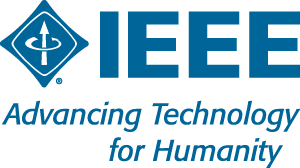Past Events - 2019
Workshop on Hyperspectral and thermal remote sensing - From Data to Applications
Dear IEEE member,
Remote sensing is a powerful and versatile technology to assess the surface of the land and natural resources. Imaging technologies and sensor design have developed extensively over the last few decades and now they are becoming more widely available for research and industrial applications. This free workshop will bring New Zealand and International remote sensing experts together to demonstrate Earth and Soil Science applications for the science community, and for the industry.
Date: 10:00-16:00, 1 October 2019
Venue: Massey University - Manawatu Campus, Palmerston North
Presentations: 18 confirmed speakers, representing research and education sectors of New Zealand, and selected international experts
Registration: Free
For further information please contact Gabor Kereszturi
(G.Kereszturi@massey.ac.nz ). Scientists, students,
staff from regional and local councils, representatives from industry are all welcome to attend however, registration is on
a first-come-first-served basis.
A flyer for the event is available from
here.
Recognition Award Received
The Section Committeee is proud to announce an award of Recognition to our membership officer Abhipray ("Abhi") Paturkar for his work in 2019 for recruitment to the IEEE New Zealand Central Section. Well done Abhi!
The Annual Joint IEEE, IET and Engineering New Zealand Institution's Breakfast Event, 11 September, 2019
 |
 |
 |
This annual joint event between the engineering institutions (IEEE, IET and Engineering New Zealand) is always worth attending as speakers are carefully chosen to reflect the interests of our respective memberships. Once again, we trust that our speaker and topic was of great interest to our members.
Date : Wednesday 11 September, 2019.
Time : 7:15am for 7:30am start on 11 September 2019
Location : Wellesley Boutique Hotel, 2 Maginnity Street, Wellington 6011
Presenter : Andrew Carroll, General Manager, Network and Field Management, Chorus
Title: "Challenges in Deploying Fibre Optic Cable to 87% of New Zealand Premises"
Cost: $15.00 for members of any of the three hosting institutions, $30.00 for any guests.
RSVP: Essential to murray.milner@xtra.co.nz (numbers are limited so first in first served for registrations)
Approximately 25 members and guests of the IEEE Central Section, IET Wellington Network and ENZ Wellington Branch were welcomed to the special event, hosted by all three institutions on the morning of 11 September 2019 in Central Wellington. The guest speaker for this event was Andrew Carroll, General Manager, Network and Field Management at Chorus, who addressed the challenges that Chorus experienced in implementing one of the largest telecommunication projects ever undertaken in New Zealand, being the deployment of fibre optic cable to 87% of New Zealand premises and the connection of these premises to the fibre.
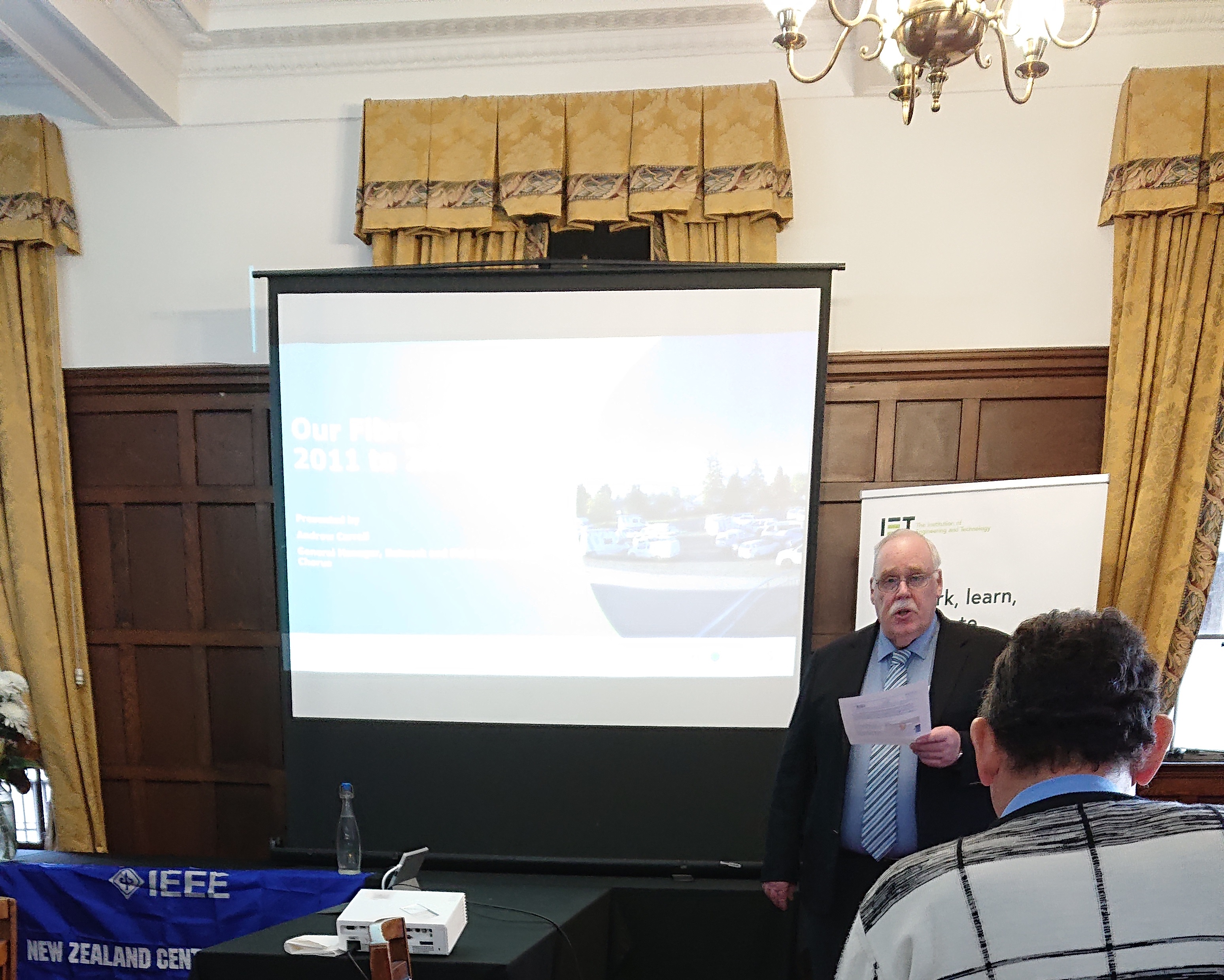 |
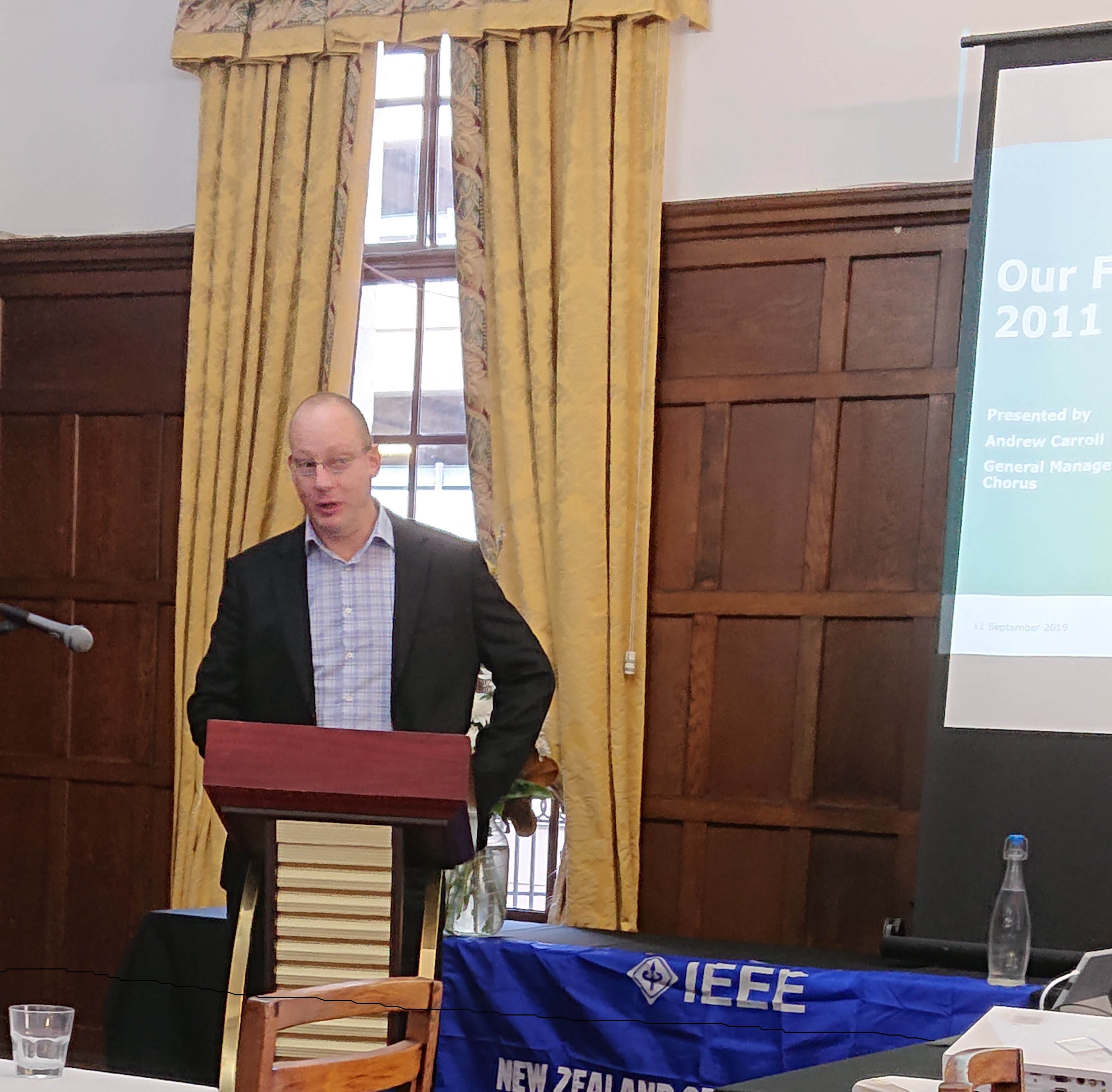 |
| Murray Milner introduces our breakfast speaker | Breakfast speaker, Andrew Carroll |
Abstract:
New Zealand's multi-billion dollar roll out of a"fibre to the home" network is one of New Zealand's largest infrastructure projects, rewiring the country on a street by street, house by house basis. It is projected to cover 87% of the population in a few years' time.
The project has overcome a number of challenges over the years, such as establishing a programme to pass one house a minute with fibre for 8 years from a standing start, and coping with installation demand many times greater than anticipated. A new set of challenges are being worked through as the roll out moves from the major urban centres to much more widely dispersed build areas. In global terms, NZ's fibre to the home programme is considered to be a leader, and much more successful than the Australian equivalent. A number of Chorus' experiences are likely to be of relevance to other projects and industries.
Introducing our Speaker:
| Andrew Carroll is responsible for Chorus' network and field management activity, including communal fibre build, fibre connect and all network maintenance. Prior to this, Andrew had been Chorus' chief financial officer from the time of demerger. Prior to Chorus, Andrew held various finance roles in Telecom and worked closely with many in the Chorus team on the ultra-fast broadband negotiations with the Crown through the demerger process. Before that, he was a director of investment banking at Credit Suisse First Boston New Zealand. |
 |
VW-Stiftung project
This was a joint MEE / CRISP / IEEE NZ Signal Processing and Information Theory Chapter seminar.
Time : 3pm - 4pm
Location : Presentation Lab (RC2.143), Riddet Building Massey University, Palmerston North
Presenter : Sven Simon, Professor of Parallel Systems, Institute of Parallel and Distributed Systems, University of Stuttgart, Germany
Title: Industrial 3D Computed Tomography with Applications in Electrical Engineering
Abstract:
After a brief introduction to the research group, and a quick overview of computed tomography, this presentation will look deeper into the basic principles of industrial computed tomography, like the image formation process and the increasing resolutions of the 3D data volume sets. Due to high resolution, the challenge of current industrial CT is huge data sets ranging from 32 GBytes to 256 GBytes per CT scan.
First research results reduce the huge amount of data by two orders of magnitude in the considered cases. In the second part of the talk applications of industrial computed tomography especially in the field of electrical engineering are discussed.
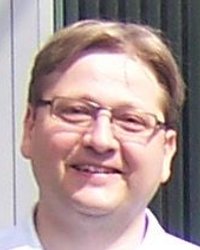 |
Presenter Biography: Sven Simon is currently Professor of Parallel Systems at the University of Stuttgart, and is leader of the Department of Parallel Systems. Sven has spent over 25 years working in the field of hardware architectures, VLSI design for signal and image processing and additionally, he has focused for the last 10 years on hardware and algorithms for computed tomography. His department operates an industrial CT scanner to conduct research in the field of computed tomography imaging and image processing on 3D volume data sets for scientific applications. He is author and co-author of more than 120 publications and over 20 patents. |
Report:
Professor Sven Simon gave a very interesting presentation on computed tomography (CT). This started from the basic principles and an introduction to reconstruction through filtered back projection. After outlining some of the typical applications primarily within the medical and industrial domains, he explained how his research group was tackling the data problem by using variable resolution data structures. He outlined some of the challenges and artefacts introduced by a broad spectrum (as typically generated by typical industrial CT machines), and showed how these can be significantly reduced by using a synchroton source. He finished by demonstrating how CT could enable internal scans of chips, enabling the impedance of transmission lines to be directly determined from the 3D structures.
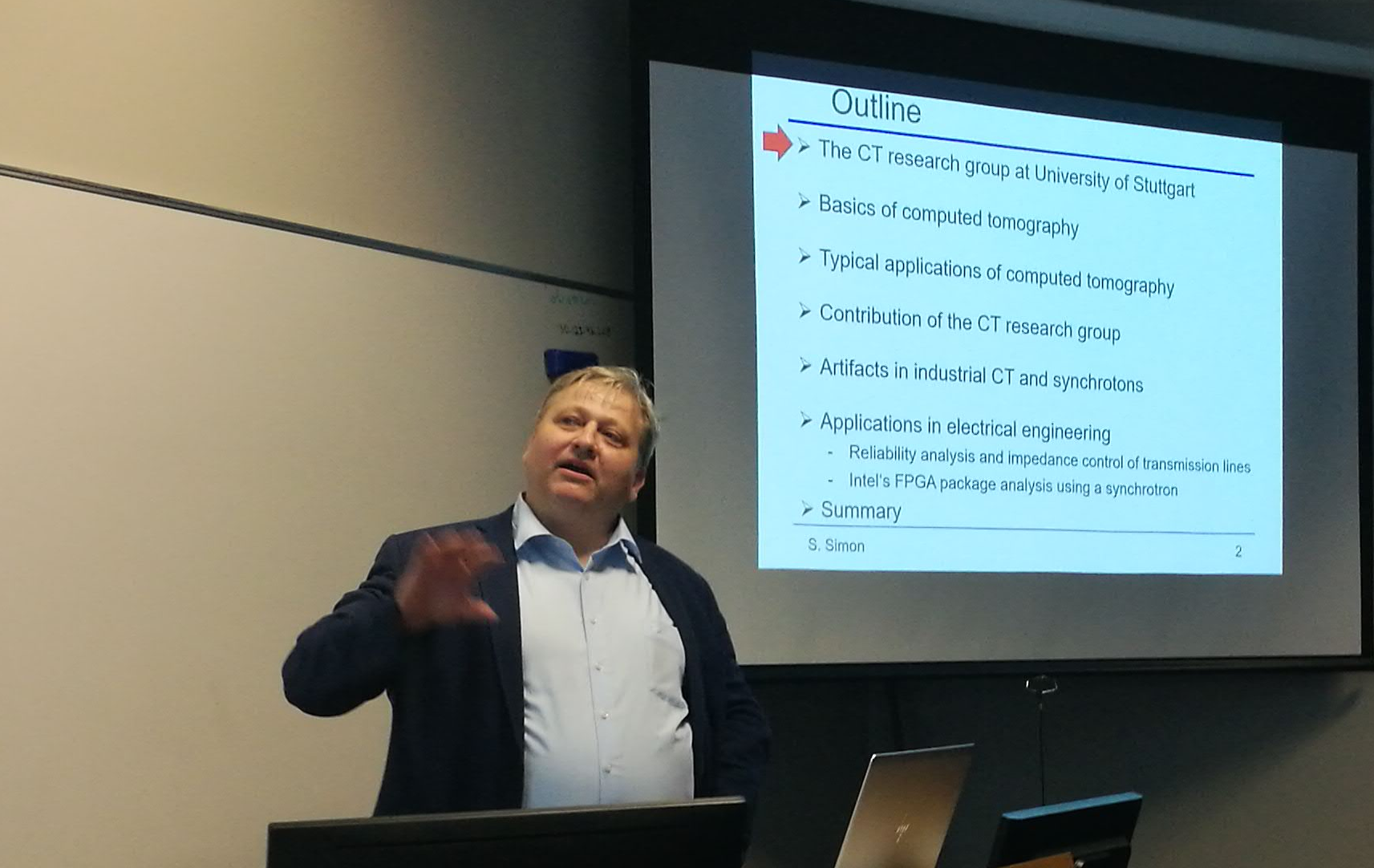
Following the presentation, there was a very active question and answer session. The seminar was attended by 42.
Public Seminar by Raghavender Goud Deshagoni (Raghu)
Raghu was awarded one of five student participation awards at the Electrical Safety Workshop held in Jacksonville, Florida, USA in March of this year. He will present his award winning paper and his observations from the conference at which it was presented.Title: Factors Determining the Effectiveness of a Wind Turbine Generator Lightning Protection System
When: 25 June 2019, 12 noon to 1pm
Where: Room CO431, Fourth Floor, Cotton Building, Kelburn Campus, Victoria University of Wellington.
All welcome.
Abstract:
As a result of the growing supply and demand for wind power, wind turbine generators are increasingly being installed at sub-optimal sites that have high soil resistivity and a high incidence of lightning strikes. This means that lightning protection systems for wind turbines are becoming a critical component of wind farm design. Not only do effective lightning protection systems ensure the safety of the physical wind turbine structure and human operators, but they also protect the electrical and control systems installed inside wind turbine generators and safeguard the lives of human operators. This presentation discusses a framework to assess the effectiveness of wind turbine lightning protection systems at the wind farm design phase. Performing the analysis at this early stage reduces lightning-induced downtime, which leads to increased energy yield. Our results show that the grounding system plays a critical role in the wind turbine lightning protection system. For this reason, we also analyse various influential parameters of a grounding system design. We present results from full-wave electromagnetic simulations of the complete wind turbine grounding system, including the foundation.
About the Author: Raghavender Goud Deshagoni
Raghavender Goud Deshagoni received his Bachelor of Technology degree in Electrical and Electronics Engineering from the Jawaharlal Nehru Technological university, India and Master of Technology degree in Electrical Engineering from the Indian Institute of Technology Roorkee, India in 2006 and 2009 respectively. He is currently pursuing his Ph.D. with the School of Engineering and Computer Science, Victoria University of Wellington, New Zealand. His research interests include lightning protection systems, earth system design, and wind turbine generators. He had worked in the electrical power industry for seven years before starting his Ph.D.
IEEE PES Distinguished Lecture by Dr. Damir Novosel
You are cordially invited to attend the following free IEEE-PES and EEA Lecture organised by the PES NZ Central Chapter, Transpower, and Victoria University of Wellington jointly with EEA. The Distinguished speaker is from IEEE Power and Energy Society visiting New Zealand to deliver the Keynote during EEA 2019 conference.Event : IEEE PES Distinguished Lecture 2019
Date : Wednesday, 26th June, 2019
Time : 1pm to 2pm
Location : Room: Mataatua, Transpower NZ Ltd., Waikoukou, 22 Boulcott Street, Wellington.
Title: Success Factors for Sustainable Electrical Energy Delivery
Speaker : Dr. Damir Novosel
President at Quanta Technology, Past IEEE PES President
Host : Dr. Ramesh Rayudu - IEEE NZCS PES Chapter Chair
Abstract:
Resilient, reliable and efficient electrical grid operation is critical to society. The electrical power and energy industry in the next decades is changing rapidly to meet the demands of the society and address challenges and decarbonization needs. New technology trends include development of more efficient, reliable, and cost-effective Distributed Energy Resources (DER), energy storage technologies, electrification, advanced monitoring and automation, and communications that offer significant opportunities for realizing a resilient and sustainable energy future.
The grid also continues to face evolving challenges, such as cyber and physical attacks, major weather events (e.g., catastrophic wildfires, hurricanes, significant rain/snow incidents) and aging infrastructure. We have the opportunity to make it better than it was before by taking more aggressive actions to adapt, including grid infrastructure hardening and improved grid and equipment monitoring. An important aspect is to recognize the value that the electrical grid brings as an enabler to increase penetration of renewable resources, improve resilience, provide market access for DER, increase electrification, lower market prices, and increase customer choice to enable inclusiveness and equality. What we need now is a renewed understanding of the value of not just electricity, but the grid that enables it, and recognize the contributions of energy resources like residential solar panels or energy storage to it.
We are at a crossroads in making business and technical decisions that will allow us to optimally and cost-effectively manage the grid. This presentation will discuss success factors for sustainable electrical energy delivery in the context of industry trends and transformation drivers and opportunities for grid modernization with technologies for the changing nature of electricity delivery.
Biography of Dr. Damir Novosel :
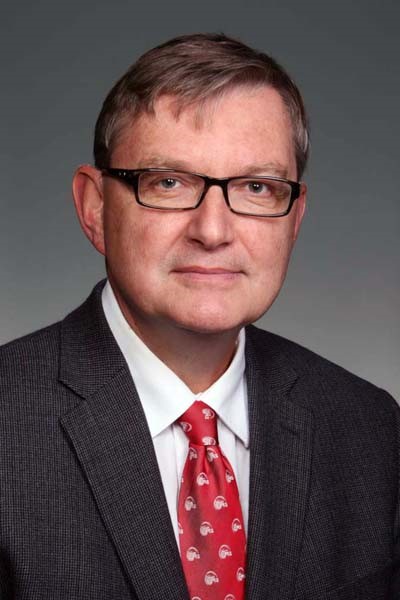 |
Damir is president and founder of Quanta Technology, a subsidiary of Quanta Services, a Fortune 500 company. Previously, he was vice president of ABB Automation Products and president of KEMA T & D US. Dr. Novosel is also an adjunct professor of Electrical Engineering at North Carolina State University. Dr. Novosel is elected to National Academy of Engineers in 2014. He served as IEEE Power and Energy Society President (2016-2017) and Vice President of Technical Activities (2011-2012). He is also a member of the CIGRE US National Committee and received the CIGRE Attwood Associate award. He is presently chairing Industry Technical Support Task Force organization responsible for IEEE cooperation with global regulatory agencies and corporate engagement. Damir holds 17 US and international patents and published over 140 articles in Transactions, Journals and Proceedings, receiving IEEE PES 2011 and 2013 Prize Paper Awards, and CIGRE distinguished paper award in 2006. He contributed to 5 books. |
Damir Novosel, an IEEE Fellow since 2003, holds PhD and MSc, BSc degrees in electrical engineering from Mississippi State University (where he was a Fulbright scholar), the University of Zagreb, Croatia, and the University of Tuzla, Bosnia and Herzegovina. Dr. Novosel was selected Mississippi State University Distinguished Engineering Fellow in 2015.
For further information, please contact: Ramesh Rayudu (Ramesh.rayudu@vuw.ac.nz)
PLEASE NOTE: If you are a non-Transpower employee, please send an RSVP to Vong (Nyuk-Min) Vong (Nyuk-MinVong.Vong@transpower.co.nz) so that access arrangements can be made.
IET / IEEE Joint Event Presented by Dr. Stuart Johnson
This a joint event talk by the IET and IEEE and will be hosted by Paul Bagg.Title: Developing a distribution network for the future proofing of households
When: Tuesday 2nd July, 2019. 12 noon - 1pm.
Where: Beca Offices, Aorangi House, 85 Molesworth Street - Please take the lift from the ground floor to the level 6 training room.
Registration required: Paul Bagg - Paul.Bagg@nzta.govt.nz
Abstract:
The talk will look at the 'Australian Open Network Program' that is future proofing household PV installations and battery systems.
About the Presenter: Dr. Stuart Johnson
Principal, Network Transformation
Stuart has diverse experience in the electricity, natural resources and university sectors. He is currently the General Manager Network Transformation at Energy Networks Australia, where he is responsible for policy and advocacy on issues of critical importance to managing transformational change for the industry, including projects such as the Electricity Network Transformation Roadmap (2017) and Open Energy Networks. He is also currently the chair of the ESI Transmission, Distribution and Rail Traction Industry Skills Committee.
THE NEW ENGINEERING NEW ZEALAND ELECTRICAL ENGINEERING GROUP LAUNCH - May 3rd, 2019
The reason for forming a new group in electrical engineering is to improve the collaboration between the institutions as discussed at the recent IEEE Region 10 AGM. It is expected that this will be a group that will address engineering issues of importance to New Zealand and so it is important that all engineers with an interest in the issues are involved, independent of the institution that they may be affiliated with. One of the drivers for the initiative is the less than ideal performance of building services infrastructure resulting from the earthquakes experienced over the last decade. However, it is expected that this will be only one of several issues of importance to business and industry within New Zealand. Hence it is essential that the best minds from around New Zealand are focused on these issues.Join us for the launch of the new Engineering New Zealand Electrical Engineering Group for an introduction to the Group's vision followed by an ideas workshop and networking. This is your chance to share ideas on what you want out of the Group and a chance to steer its direction.
Attendees will have the opportunity to register their interest for being part of the membership of this group and to put their hand up to be part of the interim committee.
Please register here: 3 May | 12.30pm - 1.30pm | Engineering New Zealand, Wellington https://pd.engineeringnz.org/ipenzt/register?sgid=e0994903513840298770a84f951f5891
3 May | 12.30pm - 1.30pm | Opus, Auckland https://pd.engineeringnz.org/ipenzt/register?sgid=2ad1dbca748c4d73a94daf1a9ef0e1c4
3 May | 12.30pm - 1.30pm | WSP Opus Christchurch https://pd.engineeringnz.org/ipenzt/register?sgid=16d141470ec84c0fbdf1db337040a5fb
More details are available from the flier located here.
2019 IEEE Congress on Evolutionary Computation - 10-13 June 2019
The IEEE Congress on Evolutionary Computation (IEEE CEC) is the flagship conference of IEEE Computational Intelligence Society, and it is the largest international conference in Evolutionary Computation in the world. IEEE CEC 2019 will be held in Te Papa, Wellington, which is the National Museum of New Zealand. This is the first time that this conference has come to New Zealand. The conference expected to attract ~600 people. Early-bird registration was due on 9 April 2019.
More information is available from their website which is located at: https://cec2019.org Two talks of interest to members include:
Public Lecture: What Can Evolutionary Computation Do For You?
Speaker: Prof. Xin Yao
Time and Room: 5:30PM -6:30PM, 11 June 2019, Soundings Theatre
Chair: Prof. Kay Chen Tan
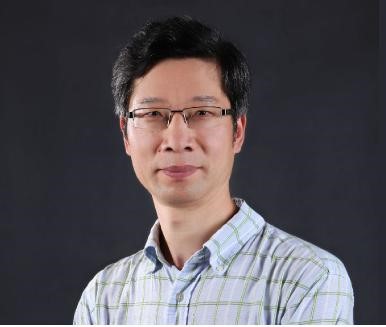 |
Abstract: Evolutionary computation refers to the study of computational systems that use ideas and get inspirations from natural systems, especially biological systems. Its primary goal is to develop more robust, reliable and self-adaptive computational systems that help to tackle complex optimisation and learning problems in the real world, from routing a fleet of trucks in a dynamically changing road networks to scheduling a large team of software engineers to develop a complex software system, from calibrating engines of cars to design artificial neural networks for pattern recognition and prediction. This talk tries to explain what evolutionary computation is, how it works and why it is interesting from both scientific research's point of view and practical application's point of view. Examples will be given throughout the talk to illustrate the potential benefits (and weaknesses) of evolutionary computation. |
More details about Professor Xin Yao (pictured above) can be obtained from this extract from the conference program or their website.
Date: 10 June 2019
Time: 10:30-11:30am
Venue: Oceania Inner South, Te Papa
Title: Advances in Evolutionary Dynamic Multi-objective Optimization
Speaker: Kay Chen Tan, IEEE Fellow, IEEE Distinguished Lecturer
Abstract: Multi-objective optimization involves simultaneous optimization of two or more objective functions that are conflicting in nature, which results in a set of trade-off solutions for a given optimization problem. Evolutionary algorithms are capable of finding diverse set of solutions in a single simulation run due to their population-based nature, therefore making them very popular in solving multi-objective optimization problems. However, real-world optimization problems can involve objective functions, decision variables and constraints that may change over time. A dynamic multi-objective optimization problem requires the evolutionary algorithm to be capable of detecting changes in the problem’s environment, and robustly tracks the changing optimal solutions to achieve a faster convergence while maintaining the diversity. In this presentation, prediction-based dynamic handling approaches will be discussed and new methods such as Kalman filter and Mixture-of-Experts dynamic handling strategies will be presented. These prediction models can learn the patterns from previous experience and predict future changes. The predictions help to guide the search towards the changed optima, thereby accelerating convergence of the optimization process. Future research directions will also be discussed in the presentation.
 |
Biography: Kay Chen Tan is a full Professor with the Department of Computer Science, City University of Hong Kong, Hong Kong. He is the Editor-in-Chief of IEEE Transactions on Evolutionary Computation, was the EiC of IEEE Computational Intelligence Magazine (2010-2013), and currently serves on the Editorial Board member of 15+ international journals. He is an elected member of IEEE CIS AdCom (2017-2019) and is an IEEE Distinguished Lecturer (2019-2021). He has published 250+ refereed articles and 6 books. He is a Fellow of IEEE. |
A flier containing the above information was also available from here.
The following report outlines this event as it transpired.
Public Seminar by Raghavender Goud Deshagoni (Raghu)
Raghu was awarded one of five student participation awards at the Electrical Safety Workshop held in Jacksonville, Florida, USA in March of this year. He will present his award winning paper and his observations from the conference at which it was presented.Title: Factors Determining the Effectiveness of a Wind Turbine Generator Lightning Protection System
When: 25 June 2019, 12 noon to 1pm
Where: Room CO431, Fourth Floor, Cotton Building, Kelburn Campus, Victoria University of Wellington.
All welcome.
Abstract:
As a result of the growing supply and demand for wind power, wind turbine generators are increasingly being installed at sub-optimal sites that have high soil resistivity and a high incidence of lightning strikes. This means that lightning protection systems for wind turbines are becoming a critical component of wind farm design. Not only do effective lightning protection systems ensure the safety of the physical wind turbine structure and human operators, but they also protect the electrical and control systems installed inside wind turbine generators and safeguard the lives of human operators. This presentation discusses a framework to assess the effectiveness of wind turbine lightning protection systems at the wind farm design phase. Performing the analysis at this early stage reduces lightning-induced downtime, which leads to increased energy yield. Our results show that the grounding system plays a critical role in the wind turbine lightning protection system. For this reason, we also analyse various influential parameters of a grounding system design. We present results from full-wave electromagnetic simulations of the complete wind turbine grounding system, including the foundation.
About the Author: Raghavender Goud Deshagoni
Raghavender Goud Deshagoni received his Bachelor of Technology degree in Electrical and Electronics Engineering from the Jawaharlal Nehru Technological university, India and Master of Technology degree in Electrical Engineering from the Indian Institute of Technology Roorkee, India in 2006 and 2009 respectively. He is currently pursuing his Ph.D. with the School of Engineering and Computer Science, Victoria University of Wellington, New Zealand. His research interests include lightning protection systems, earth system design, and wind turbine generators. He had worked in the electrical power industry for seven years before starting his Ph.D.
2019 International Instrumentation and Measurement Technology Conference
The IEEE I2MTC - International Instrumentation and Measurement Technology Conference - is the flagship conference of the IEEE Instrumentation and Measurement Society, and is dedicated to advances in measurement methodologies, measurement systems, instrumentation, and sensors in all areas of science and technology. These features make I2MTC a unique event and one of the most important conferences in the field of instrumentation and measurement.IEEE I2MTC is proposed as a catalyst to promote interactions between industry and academia. A wide spectrum of research results will be presented, with potential practical applications in current industrial technology, as well as industry and application driven developments.
More information is available from their website which is located at: https://i2mtc2019.ieee-ims.org/
Recruitment Goal Award - 2019
Dear Members,
We are pleased to announce that our Section has been given an award by the IEEEE in recognition for meeting its recruitment goal
for the 2019 membership year. This goal is based upon
our four year performance and it is reproduced below. We
hope that we shall be able to continue to provide service and
benefits to all our members into the future!
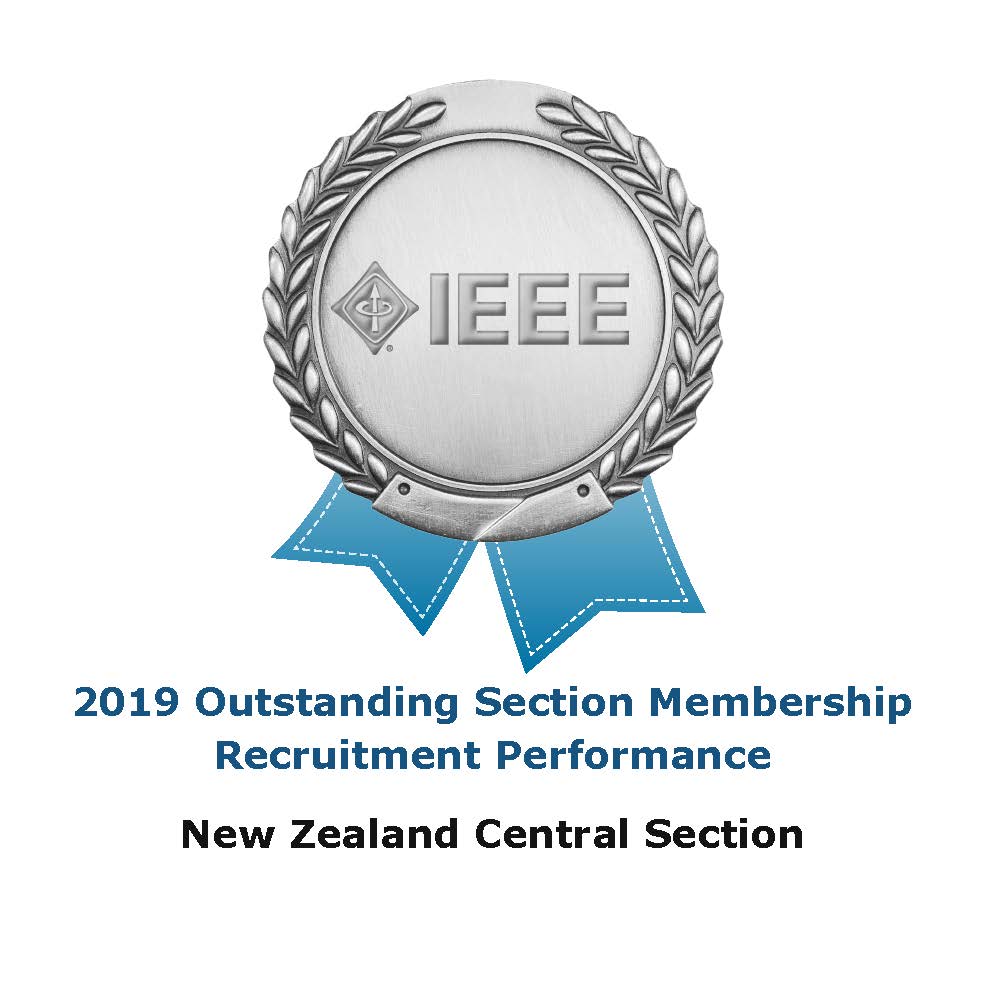
Small Section Award - 2018
Dear IEEE NZ Central Section members,
We are proud to announce that our Section received the
2018 Outstanding Small Section Award from the IEEE. It is a most welcome recognition for our efforts and
achievements in fostering technological excellence in our region, through the organisation of seminars, conferences and other networking events.
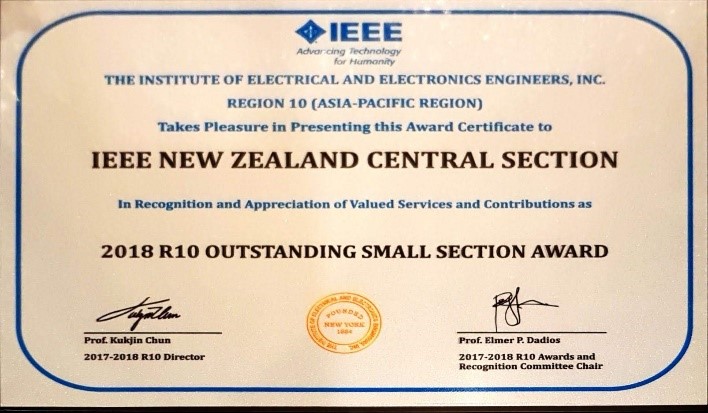
The award was presented to Dr Murray Milner, Chair of our Central Section, at the recent R10 Annual General meeting
and his report and further details are available below:
Best regards,
Your Section Committee.
IEEE Region 10 Annual General Meeting
The Annual General Meeting of IEEE Region 10 was held in Melbourne on 2-3 March 2019. The meeting commenced on the
morning of the Saturday with a roll call and finished on Sunday evening with a casual dinner. Formal meetings were
held all day on Saturday and for the morning of Sunday.
The meeting was attended by our chair of the Section, Murray Milner and Donald Bailey, Chair of the IEEE New Zealand
council and a brief report from Murray on this meeting is
available from here.
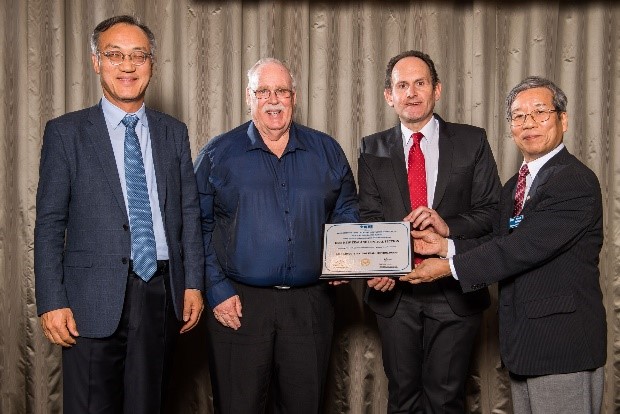
Presentation of the award to Murray and Donald at the meeting.
Link to the Region 10 Newsletters
The full announcement of the award winners that includes our Central Section can be found in the Region 10 Newsletter site which can be accessed at https://www.ieeer10.org/r10-newsletter/ with the entry listed as the "Quarter 1: March Edition". In that newsletter, you will find a 1-page article about our Section which has been compiled by our Section Secretary, Steven LeMoan in order to inform the wider IEEE community about our work and activities. More recent newsletters are also available from this site, use the menu provided to access the latest issuses.Multicore World conference 12 - 14 February 2019
About Multicore World
You were invited to participate in the 8th Multicore World, the most important high-tech conference in the Southern
Hemisphere - held yearly in Wellington, and offers a 10% discount available to IEEE members until 1 February.
Known by the speakers as "the Davos of Tech", Multicore World 2019 will be 12, 13, 14 February and feature global leaders
in a limited audience event that provides the knowledge and strategies to future-proof your technological innovation.
Don't just imagine the future: discuss it together with who is designing and building it!
Speakers
were from Intel, Arm, Facebook, Oracle, Broadcom as well as from the major US National Labs (Oak Ridge, Los Alamos,
Argonne, PNNL) and from Japan, Singapore, Netherlands, UK, and more converge every year at Multicore World to discuss at
peer-level about next-gen computing and its applications to all fields.
Visit multicore.world for full information about speakers, abstracts, schedule, tickets and venue.
Available from here was a flyer for the event.
2019 International Instrumentation and Measurement Technology Conference
The IEEE I2MTC - International Instrumentation and Measurement Technology Conference - is the flagship conference of the IEEE Instrumentation and Measurement Society, and is dedicated to advances in measurement methodologies, measurement systems, instrumentation, and sensors in all areas of science and technology. These features make I2MTC a unique event and one of the most important conferences in the field of instrumentation and measurement.IEEE I2MTC is proposed as a catalyst to promote interactions between industry and academia. A wide spectrum of research results will be presented, with potential practical applications in current industrial technology, as well as industry and application driven developments.
More information is available from their website which is located at: https://i2mtc2019.ieee-ims.org/

